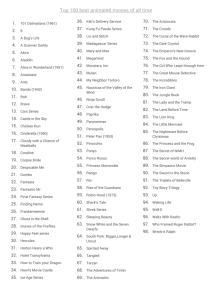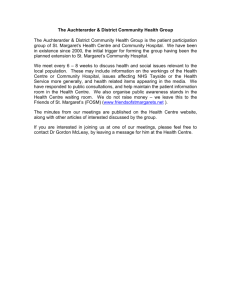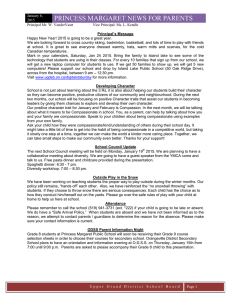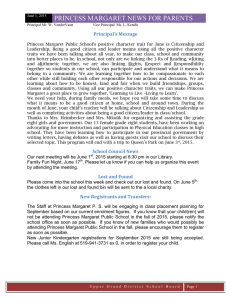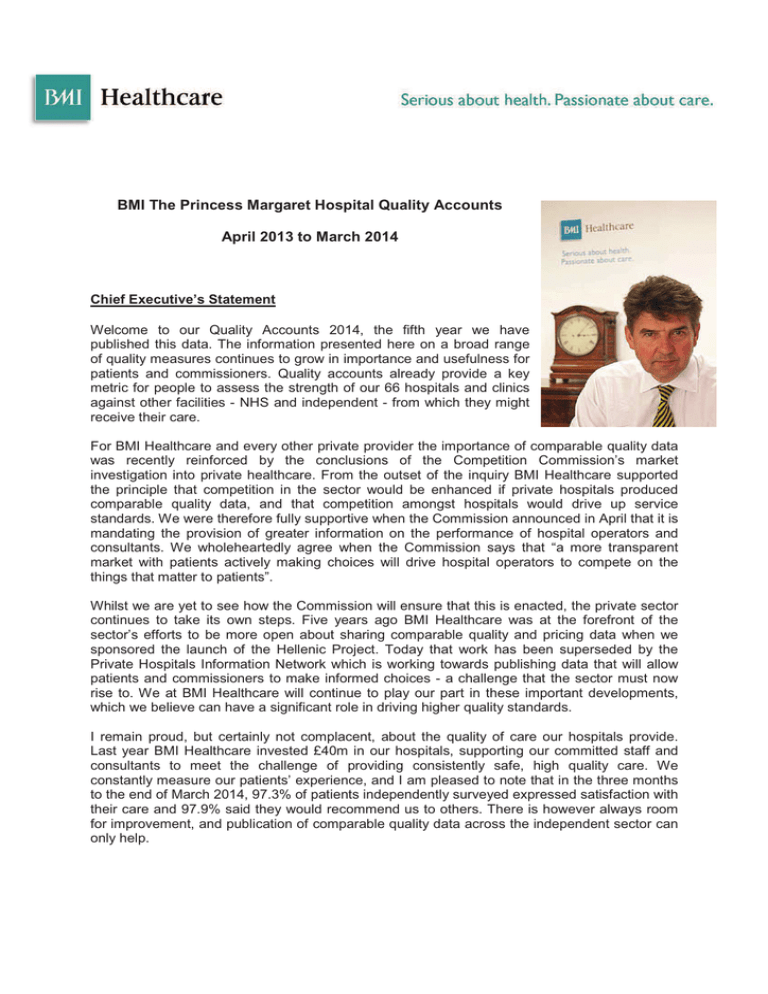
BMI The Princess Margaret Hospital Quality Accounts
April 2013 to March 2014
Chief Executive’s Statement
Welcome to our Quality Accounts 2014, the fifth year we have
published this data. The information presented here on a broad range
of quality measures continues to grow in importance and usefulness for
patients and commissioners. Quality accounts already provide a key
metric for people to assess the strength of our 66 hospitals and clinics
against other facilities - NHS and independent - from which they might
receive their care.
For BMI Healthcare and every other private provider the importance of comparable quality data
was recently reinforced by the conclusions of the Competition Commission’s market
investigation into private healthcare. From the outset of the inquiry BMI Healthcare supported
the principle that competition in the sector would be enhanced if private hospitals produced
comparable quality data, and that competition amongst hospitals would drive up service
standards. We were therefore fully supportive when the Commission announced in April that it is
mandating the provision of greater information on the performance of hospital operators and
consultants. We wholeheartedly agree when the Commission says that “a more transparent
market with patients actively making choices will drive hospital operators to compete on the
things that matter to patients”.
Whilst we are yet to see how the Commission will ensure that this is enacted, the private sector
continues to take its own steps. Five years ago BMI Healthcare was at the forefront of the
sector’s efforts to be more open about sharing comparable quality and pricing data when we
sponsored the launch of the Hellenic Project. Today that work has been superseded by the
Private Hospitals Information Network which is working towards publishing data that will allow
patients and commissioners to make informed choices - a challenge that the sector must now
rise to. We at BMI Healthcare will continue to play our part in these important developments,
which we believe can have a significant role in driving higher quality standards.
I remain proud, but certainly not complacent, about the quality of care our hospitals provide.
Last year BMI Healthcare invested £40m in our hospitals, supporting our committed staff and
consultants to meet the challenge of providing consistently safe, high quality care. We
constantly measure our patients’ experience, and I am pleased to note that in the three months
to the end of March 2014, 97.3% of patients independently surveyed expressed satisfaction with
their care and 97.9% said they would recommend us to others. There is however always room
for improvement, and publication of comparable quality data across the independent sector can
only help.
The information available in these quality accounts has been reviewed by the Clinical
Governance Board and I declare that as far as I am aware the information contained in these
reports is accurate. I thank all the staff whose energy and devotion to improvement is
represented here and, more importantly, in the experiences of every patient who steps across
our threshold.
Stephen Collier
Chief Executive Officer
Hospital Information
BMI The Princess Margaret Hospital, in Windsor, Berkshire has 78 beds with rooms furnished to
a high standard and offering the privacy and comfort of en-suite facilities, satellite TV and
telephone. The hospital has four operating theatres, 17 outpatient consulting rooms, a dedicated
day care ward, chemotherapy unit, pharmacy, endoscopy, physiotherapy and imaging
departments with onsite MRI and CT.
Our consultants are supported by caring and professional medical staff, including highly
qualified nursing teams and Resident Medical Officers 24 hours a day, ensuring the highest
quality care in a friendly and comfortable environment.
Since launching the Hand and Wrist service in 2012, the hospital has invested in a dedicated
hand clinic that is part of the physiotherapy department and is run by experienced staff.
The introduction of 2 new spinal surgeons has seen a steady increase in spinal surgery at the
hospital. This is supported by a robust multidisciplinary team (MDT) who hold regular meetings,
training and case reviews.
2014-2015 will see a significant investment in a new self-contained Endoscopy Unit at BMI The
Princess Margaret hospital and this work will commence during the course of this year.
This will free up space in the Outpatient department, where Endoscopy is currently located and
may lead to future development in that area.
BMI The Princess Margaret Hospital continues to participate in the Choice Network for NHS
patients offering a range of services for patients to choose their hospital and surgeon. NHS
patients accounted for 9% of the overall caseload at PMH in 2013.
BMI Healthcare is registered as a provider with the Care Quality Commission (CQC) under the
Health & Social Care Act 2008. BMI The Princess Margaret Hospital is registered as a location
for the following regulated services:•
•
•
Treatment of disease, disorder and injury
Surgical procedures
Diagnostic and screening
The CQC carried out a routine, unannounced inspection on 2 October 2013 and found that BMI
The Princess Margaret Hospital met all standards on which it was inspected.
Safeguarding people who use services from abuse
Care and welfare of people who use services
Meeting nutritional needs
Management of medicines
Staffing
BMI The Princess Margaret Hospital has a local framework through which clinical effectiveness,
clinical incidents and clinical quality is monitored and analysed. Where appropriate, action is
taken to continuously improve the quality of care. This is through the work of a multidisciplinary
group and the Medical Advisory Committee.
Regional Clinical Quality Assurance Groups monitor and analyse trends and ensure that the
quality improvements are operationalised. Where appropriate, action is taken to continuously
improve the quality of care, this is through the work of the clinical governance team, multidisciplinary teams and supported by the Medical Advisory Committee.
At corporate level the Clinical Governance Board has an overview and provides the strategic
leadership for corporate learning and quality improvement.
There has been ongoing focus on robust reporting of all incidents, near misses and outcomes.
Data quality has been improved by ongoing training and database improvements. New reporting
modules have increased the speed at which reports are available and the range of fields for
analysis. This ensures the availability of information for effective clinical governance with
implementation of appropriate actions to prevent recurrences in order to improve quality and
safety for patients, visitors and staff.
At present we provide full, standardised information to the NHS, including coding of procedures,
diagnoses and co-morbidities and PROMs for NHS patients.There are additional external
reporting requirements for CQC, Public Health England (Previously HPA) CCGs and Insurers
BMI is a founding member of the Private Healthcare Information Network (PHIN) UK – where
we produce a data set of all patient episodes approaching HES-equivalency and submit this to
PHIN for publication. The data is made available to common standards for inclusion in
comparative metrics, and is published on the PHIN website http://www.phin.org.uk. This website
gives patients information to help them choose or find out more about an independent hospital
including the ability to search by location and procedure
1. Safety
1.1 Infection prevention and control
The focus on infection prevention and control continues under
the leadership of the Group Director of Infection Prevention and
Control, in liaison with the Infection Prevention and Control
Lead at BMI The Princess Margaret Hospital.
We have had: • Zero cases of MRSA bacteraemia in the last year (NHS
1.17cases/100,000 bed days).
• Zero cases of MSSA bacteraemia /100,000 bed days.
• Zero cases E.coli bacteraemia cases/ 100,000 bed days.
• Zero cases of hospital apportioned Clostridium difficile in the last 12 months.
Monthly audits are undertaken across the hospital for departmental Infection Prevention and
control and Environmental measures and the annual average score is 98%. Key actions around
sourcing of corporate patient information documentation on infections and promoting
communication between the laboratory team and the IPC Lead nurse.
An antibiotic audit was undertaken in January 2014 which showed positive improvement on
documentation and adherence to antibiotic prescribing policies.
Care Bundles in place at the Princess Margaret include:• peripheral line insertion and ongoing care
• urinary catheter insertion and ongoing care
• surgical site care intraoperative and post-operative
• central line insertion / ongoing care.
All these care bundles are measured by regular audits undertaken by the IPC Lead with an
overall average of 98% compliance. Key themes are around documentation and record-keeping.
The Princess Margaret hospital undertakes monthly WHO hand hygiene audits across all
departments and the average overall score is 94%
Environmental cleanliness is also an important factor in infection prevention and our patients
rate the cleanliness of our facilities highly.
1.2 Patient Led Assessment of the Care Environment (PLACE)
We believe a patient should be cared for with compassion and dignity in a clean, safe environment.
Where standards fall short, they should be able to draw it to the attention of managers and hold the
service to account. PLACE assessments will provide motivation for improvement by providing a clear
message, directly from patients, about how the environment or services might be enhanced.
In 2013 we introduced PLACE, which is the new system for assessing the quality of the patient
environment, replacing the old Patient Environment Action Team (PEAT) inspections.
The assessments involve patients and staff who assess the hospital and how the environment
supports patient’s privacy and dignity, food, cleanliness and general building maintenance. It focuses
entirely on the care environment and does not cover clinical care provision or how well staff are
doing their job.
The results will show how hospitals are performing nationally and locally. The PLACE audit was
undertaken at the princess Margaret hospital in April 2013 and 2 patients took part alongside 2 staff
members and the results were positive. An action plan was produced and implemented following the
audit, some of these actions included making additions to some of the internal signage for patients.
There was an improvement in patient rooms following the recent upgrade prior to this audit of patient
bathrooms with new shower units. Other action was around external lighting, and review and
changes to patients’ menu choices. The results are shown in the below table.
Cleanliness
95.74%
Food
88.52%
Privacy, dignity and
Condition, appearance
wellbeing
and maintenance
89.19%
94.23%
1.3 Venous Thrombo-embolism (VTE)
BMI Healthcare, holds VTE Exemplar Centre status by the Department of Health across its
whole network of hospitals including, The Princess Margaret Hospital. BMI Healthcare was
awarded the Best VTE Education Initiative Award category by Lifeblood in February 2013 and
were the Runners up in the Best VTE Patient Information category.
We see this as an important initiative to further assure patient safety and care. We audit our
compliance with our requirement to VTE risk assess every patient who is admitted to our facility
by monthly audits of patient notes and the results of our audit on this has shown high
compliance with a yearly average of 99.6%.
The Princess Margaret Hospital reports the incidence of Venous Thromboembolism (VTE)
through the corporate clinical incident system. It is acknowledged that the challenge is receiving
information for patients who may return to their GPs or other hospitals for diagnosis and/or
treatment of VTE post discharge from the Hospital. As such we may not be made aware of
them. We continue to work with our Consultants and referrers in order to ensure that we have
as much data as possible. .
There were no reported DVTs or PEs during April 2013 to March.
2. Effectiveness
2.1 Patient reported Outcomes (PROMS)
Patient Reported Outcome Measures (PROMs) are a means of collecting information on the
effectiveness of care delivered to NHS patients as perceived by the patients themselves.
PROMs is a Department of Health led programme.
The Princess Margaret hospital ensures all eligible NHS patients are encouraged to complete
the PROMs questionnaire prior to admission, asking at the Pre-assessment appointment,
however the numbers of patients eligible at the hospital, are extremely low. This has resulted in
no Hospital data being available in the annual results for the Oxford Hip Score.
For the current reporting period, the tables below demonstrate that the health gain between
Questionnaire 1 (pre-operative) and Questionnaire 2 (post–operative) for patients undergoing
knee replacement surgery at The Princess Margaret Hospital.
Oxford Hip Score average
April 2012 March 2013
Princess
Margaret
Hospital
Q1
Q2
Health gain (Q2 - Q1 average)
No data
available
No data
available
Due to small numbers undertaken,
insufficient data to provide any results
17.907
39.224
21.317
England
Copyright © 2011 Re-used with the permission of The Health and Social Care Information Centre. All rights reserved.'
Oxford Knee Score average
April 2012 March 2013
Princess
Margaret
Hospital
Q1
Q2
Health gain (Q2 - Q1 average)
24.25
42.125
17.875
17.907
39.224
21.317
England
Copyright © 2013, The Health and Social Care Information Centre. All Rights Reserved.
2.2 Enhanced Recovery Programme (ERP)
The ERP is about improving patient outcomes and speeding up a patient’s recovery after
surgery. ERP focuses on making sure patients are active participants in their own recovery and
always receive evidence based care at the right time. It is often referred to as rapid recovery, is
a new, evidence-based model of care that creates fitter patients who recover faster from major
surgery. It is the modern way for treating patients where day surgery is not appropriate.
ERP is based on the following principles:1. All Patients are on a pathway of care
a. Following best practice models of evidenced based care
b. Reduced length of stay
2. Patient Preparation
a. Pre Admission assessment undertaken
b. Group Education sessions
c. Optimizing the patient prior to admission – i.e HB optimisation, control comorbidities, medication assessment – stopping medication plan.
d. Commencement of discharge planning
3. Proactive patient management
a. Maintaining good pre-operative hydration
b. Minimising the risk of post-operative nausea and vomiting
c. Maintaining normothermia pre and post operatively
d. Early mobilisation
4. Encouraging patients have an active role in their recovery
a. Participate in the decision making process prior to surgery
b. Education of patient and family
c. Setting own goals daily
d. Participate in their discharge planning
The hospital has an ERP committee that meets every 2-3 months, with multidisciplinary
representation including a consultant orthopaedic surgeon. An audit is due to be undertaken in
June 2014 to measure progress taken since initial implementation. The hospital has purchased
warming devices for use pre operatively and has commenced pre carbohydrate drinks. Patient
information documentation has been and continues to be a focus at the ERP meetings.
2.3 Unplanned Readmissions within 31 days and unplanned returns to theatre.
Unplanned readmissions and unplanned returns to theatre are normally due to a clinical
complication related to the original surgery. Our figures remain very low. We always encourage
patients to contact the hospital after discharge with any concerns they may have and undertake
post-discharge follow-up telephone calls.
hŶƉůĂŶŶĞĚZĞĂĚŵŝƐƐŝŽŶǁŝƚŚŝŶϯϭĚĂLJƐ
;ZĂƚĞƉĞƌϭϬϬŝƐĐŚĂƌŐĞƐͿ
Ϭ͘ϯϱϬ
Ϭ͘ϯϬϬ
Ϭ͘Ϯϵϯϭ
Ϭ͘Ϯϱϳϲ
ϮϬϬϵ
Ϭ͘ϮϱϬ
Ϭ͘ϮϬϬ
Ϭ͘ϭϲϭϭ
Ϭ͘ϭϳϮϭ
ϮϬϭϬ
Ϭ͘ϭϯϮϳ
Ϭ͘ϭϱϬ
Ϭ͘ϭϭϮϳ
ϮϬϭϭ
ϮϬϭϰ
ϮϬϭϰ
ϮϬϭϯ
Ϭ͘ϬϬϬ
ϮϬϭϮ
ϮϬϭϯ
ϮϬϭϭ
Ϭ͘ϬϱϬ
ϮϬϭϬ
ϮϬϭϮ
ϮϬϬϵ
Ϭ͘ϭϬϬ
3. Patient experience
3.1 Patient satisfaction
BMI Healthcare is committed to providing the highest levels of quality of care to all of our
patients. We continually monitor how we are performing by asking patients to complete a patient
satisfaction questionnaire. Patient satisfaction surveys are administered by an independent third
party.
dKd>Wd/Ed^
D/dŚĞWƌŝŶĐĞƐƐDĂƌŐĂƌĞƚ,ŽƐƉŝƚĂů
ƌƌŝǀĂůƉƌŽĐĞƐƐ
ŽŶƐƵůƚĂŶƚͬŶĂĞƐƚŚĞƚŝƐƚ
ŽŶƐƵůƚĂŶƚ^ƵƌŐĞŽŶͬWŚLJƐŝĐŝĂŶ
EƵƌƐŝŶŐĐĂƌĞ
ĐĐŽŵŵŽĚĂƚŝŽŶ
ĂƚĞƌŝŶŐ
ŝƐĐŚĂƌŐĞƉƌŽĐĞĚƵƌĞ
YƵĂůŝƚLJŽĨĐĂƌĞ
DĞƚͬĞdžĐĞĞĚĞĚĞdžƉĞĐƚĂƚŝŽŶ
ZĞĐŽŵŵĞŶĚĂƚŝŽŶ;ĚĞĨŝŶŝƚĞůLJнƉƌŽďĂďůLJͿ
ϮϬϭϮͲϯ
ϵϰ͘ϴ
ϵϳ͘ϴ
ϵϴ͘ϯ
ϵϱ͘ϯ
ϵϰ͘Ϭ
ϴϴ͘Ϭ
ϴϴ͘ϵ
ϵϴ͘ϭ
ϵϴ͘ϭ
ϵϴ͘ϲ
ϮϬϭϯͲϰ
ϵϰ͘ϭ
ϵϴ͘ϰ
ϵϴ͘ϱ
ϵϲ͘ϭ
ϵϱ͘ϲ
ϴϱ͘ϭ
ϵϬ͘Ϯ
ϵϳ͘Ϯ
ϵϳ͘ϵ
ϵϳ͘ϴ
The Princess Margaret Hospital holds monthly Quality meetings with full terms of reference and
representatives from each department throughout the hospital and this forum reviews results of
patient feedback reports and identifies areas for action. The hospital also has Operational
Excellence Standards in place which support a standardised best practice approach to shaping
its customer care through training and developing its staff. During the earlier part of 2013, there
were significant essential building works being carried out, which affected some areas of patient
satisfaction in relation to noise disturbance; this work has all been completed.
3.2 Complaints
In addition to providing all patients with an opportunity to complete a satisfaction survey BMIthe
Princess Margaret Hospital actively encourages feedback both informally and formally. Patients
are supported through a robust complaints procedure, operated over three stages:
Stage 1: Hospital resolution
Stage 2: Corporate resolution
Stage 3: Patients can refer their complaint to independent adjudication if they are not satisfied
with the outcome at the other 2 stages.
The above table indicates written complaints calculated per 100 admissions. The main themes
during this period were:•
•
•
Financial
Clinical
Other
All complaints and trends are reviewed at clinical governance committee meetings with actions
agreed.
4. CQUINS
The National and local agreed CQUINs for the Princess Margaret hospital in 2013-14 were:
Friends and family
•
The response rate target was achieved and increased during the year and was 28% for
the last quarter.
•
The hospital participated in an annual Staff survey which included the Friends and
Family question for the first time.
Safety Thermometer
•
The hospital participated in this measure months and there were no incidences during
the year of pressure ulcers, VTEs, falls, urinary tract infections in the monthly data
submitted.
VTE Risk assessment
•
This is audited monthly and any areas for improvement reported back to ward teams.
This was achieved with a yearly average of over 98%.
Surgical Care Bundles
•
Completion of monthly audits – achieved
•
Increase best practice use of catheters – achieved with score of 97%.
Post-surgical remote follow up
•
To record follow up calls – this was met as demonstrated in monthly audits of notes
•
To increase post-surgical follow up calls – 96% achievement for this measure
5. National Clinical Audits
The Princess Margaret Hospital was only eligible to participate in National Joint Registry audit
and all joint replacements are submitted to this.
6. Research
No NHS patients were recruited to take part in research.
7. Priorities for service development and improvement
Endoscopy
Plans have been submitted for new unit within the hospital which will provide a fully compliant
self-contained unit for a seamless patient journey. It is envisaged that this work will commence
later in 2014.
Preadmission
Focus will continue on this as an important aspect of the patient journey and actions proposed
to increase patients’ telephone and or face-to-face assessments with an emphasis on patient
education.
Outpatient Areas
With outpatient activity continuing to grow year on year, the hospital has appointed an
Outpatient Manager, who will start summer 2014 and will focus on the clinical environment,
patient experience and documentation.
Enhanced Recovery Programme
The hospital will continue to develop initiatives in relation to ERP, with the focus on measures to
continually improve our patient outcomes and satisfaction scores
8. Mandatory Quality Indicators
8.1 The value and banding of the summary hospital-level mortality indicator (SHMI) for the
Princess Margaret Hospital for the reporting period.
Unit
0
Reporting Periods
(at least last two
reporting periods)
N/A
National
Average
1.006
Highest National
Score
1.1822
Lowest National
Score
0.6735
8.2 The Princess Margaret Hospital patient reported outcome measures scores for
(i) Groin hernia surgery
Unit
Reporting Periods
(at least last two
reporting periods)
*
National
Average
0.083
Highest National
Score
0.157
Lowest National
Score
0.014
The Princess Margaret Hospital had less than 30 patients go through this process so cannot be
scored.
(ii) Varicose vein surgery
Unit
Reporting Periods
(at least last two
reporting periods)
National
Average
Highest National
Score
Lowest National
Score
*
The Princess Margaret Hospital had less than 30 patients go through this process so cannot be
scored.
(iii) Hip replacement surgery
Unit
*
Reporting Periods
(at least last two
reporting periods)
National
Average
21.280
Highest National
Score
24.684
Lowest National
Score
17.214
The Princess Margaret Hospital had less than 30 patients go through this process so cannot be
scored
(iv) Knee replacement surgery during the reporting period.
Unit
Reporting Periods
(at least last two
reporting periods)
0
National
Average
15.99
Highest National
Score
20.37
Lowest National
Score
12.2
8.3 (i) The percentage of patients aged 0-14 readmitted to a hospital which forms part of the
Princess Margaret Hospital within 28 days of being discharged from a hospital which forms part
of the hospital during the reporting period.
Unit
Reporting Periods
(at least last two
reporting periods)
National
Average
Highest National
Score
Lowest National
Score
N/A
8.3.(ii)The percentage of patients aged 15 or over readmitted to a hospital which forms part of
the Princess Margaret Hospital within 28 days of being discharged from a hospital which forms
part of the hospital during the reporting period.
Unit
Reporting Periods
(at least last two
reporting periods)
National
Average
Highest National
Score
Lowest National
Score
0
8.4 The Princess Margaret Hospital responsiveness to the personal needs of its patients during
the reporting period.
Unit
Reporting Periods
(at least last two
reporting periods)
91.58
National
Average
68.1
Highest National
Score
84.4
Lowest National
Score
57.4
8.5 The percentage of patients who were admitted to Princess Margaret Hospital and who were
risk assessed for venous thromboembolism during the reporting period.
Unit
98%
Reporting Periods
(at least last two
reporting periods)
National
Average
Highest National
Score
Lowest National
Score
96
100
79
8.6 The rate per 100,000 bed days of cases of C difficile infection reported within the Princess
Margaret hospital amongst patients aged 2 or over during the reporting period.
Unit
Reporting Periods
(at least last two
reporting periods)
0
National
Average
17.3
Highest National
Score
30.8
Lowest National
Score
0
8.7 The number and, where available, rate of patient safety incidents reported within the
Princess Margaret Hospital during the reporting period, and the number and percentage of such
patient safety incidents that resulted in severe harm or death.
Number of patient safety incidents reported
Unit
Reporting Periods
(at least last two
reporting periods)
0
National
Average
44.55
Highest National
Score
1,810
Lowest National
Score
0
Rate of patient safety incidents reported
Unit
Reporting Periods
(at least last two
reporting periods)
0
National
Average
7.76
Highest National
Score
30.95
Lowest National
Score
1.68
Number of patient safety incidents that resulted in severe harm or death
Unit
Reporting Periods
(at least last two
reporting periods)
0
National
Average
0.64
Highest National
Score
28
Lowest National
Score
0
Percentage of patient safety incidents that resulted in severe harm or death
Unit
0
Reporting Periods
(at least last two
reporting periods)
National
Average
0.9
Highest National
Score
2.9
Lowest National
Score
0
8.8 The percentage of staff employed by the Princess Margaret hospital during the reporting
period, who would recommend the Princess Margaret Hospital as a provider of care to their
family or friends.
Unit
Reporting Periods
(at least last two
reporting periods)
80.5%
National
Average
64.58
Highest National
Score
96.43
Lowest National
Score
33.73
9. Non-Mandatory Quality Indicators
9.1 The percentage of patients who received care as inpatients or discharged from A &E during
the reporting period, who would recommend the Princess Margaret Hospital as a provider of
care to their family or friends.
Unit
80.55
Reporting Periods
(at least last two
reporting periods)
National
Average
66.23
Highest National
Score
94.38
Lowest National
Score
35.63
The Princess Margaret Hospital considers that this data is as described for the following
reasons; patients have always been very happy with their care at the hospital and are very
complimentary of staff which is demonstrated in the patient feedback. We will continue work to
maintaining this high quality care and to value customer responses.


